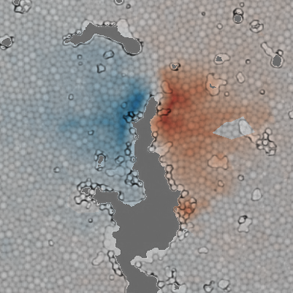The Poromechanics Lab, Environmental Fluid Mechanics Group

Poromechanics
Academics:

The Poromechanics Lab
The Poromechanics Lab is an interdisciplinary team of engineers, physicists, mathematicians, and geoscientists. We study flow, transport, and deformation in multiphase systems from a variety of different perspectives, ranging from subsurface engineering (e.g., energy and water resources) to soft porous materials (e.g., gels and tissues). We use a combination of mathematical models, numerical simulations, and high-resolution laboratory experiments to develop physical insight into these complex natural and industrial systems.
Gas Migration in the Subsurface
The buoyancy-driven migration of large gas plumes through water-saturated rocks is central to several applications in subsurface engineering, including carbon capture and geological storage (CCS) and the identification and exploration of hydrocarbon reservoirs. We are working with collaborators in Oxford Earth Sciences to develop improved models for gas migration that are informed by geophysical observations.
Gas Bubbles in Soft Sediments
The nucleation, growth, and migration of macroscopic gas bubbles in soft, liquid-saturated sediments is important for methane venting from lake and sea beds, mixing in chemical reactors, and outgassing from industrial waste ponds. A clear and predictive understanding of the venting rate is central to aquatic ecosystems and the natural carbon cycle in the context of lakes and oceans, and to waste-management and safety considerations in the context of waste ponds. We are working with collaborators in the Oxford Mathematical Institute and at the University of Minnesota to develop new continuum models and laboratory analogue experiments that will allow us to better understand the growth and migration of bubbles in these soft granular systems.
Multiphase Frictional Flows
Multiphase frictional flows involve the simultaneous flow of two fluids in the presence of a granular solid in a confined geometry, such as a narrow flow cell or a tube -- for example, gas displacing a mixture of water and sand from a pipe. Multiphase frictional flows occur in a wide range of natural and industrial processes, including soil and mud flows, methane venting from sediments, degassing of volatiles from magma, multiphase oil/gas/sand/proppant flows during the recovery of hydrocarbons, fluidised bed chemical reactors, and the processing of granular and particulate systems in food, pharmaceutical, and numerous other industries. Despite the abundance and importance of these processes, a fundamental understanding of the underlying physics is lacking. These systems are inherently difficult to predict and control because of their complexity, which manifests itself through the self-organization of a wide variety of intricate patterns. We are working with collaborators in the Oxford Mathematical Institute and at Swansea University to develop a new continuum model for these flows.
Solute Transport in Soft Porous Media
The transport of solutes is important to many soft porous systems, including the movement of contaminants in soils and the movement of nutrients and waste in living tissues and tissue-engineering scaffolds. These systems are also often exposed to large periodic deformations, which can drive nontrivial fluid motion and changes in pore structure. We are working with collaborators in the Oxford Mathematical Institute and at IIT Gandhinagar to use homogenization theory, continuum models, and laboratory analogue experiments to better understand the coupling between solute transport and (changing) pore structure in soft porous materials.
